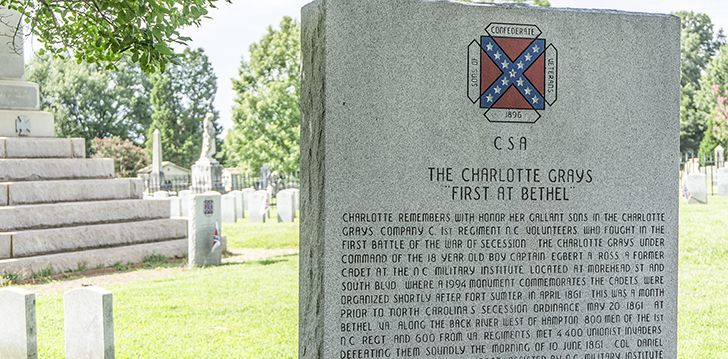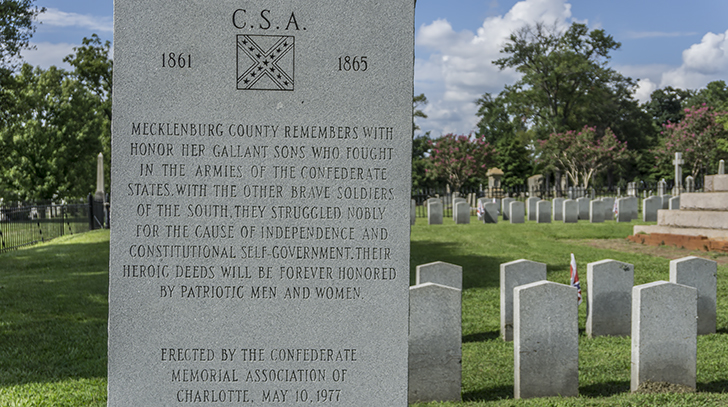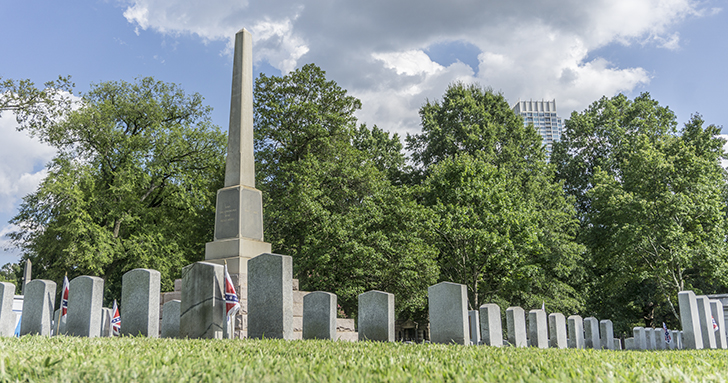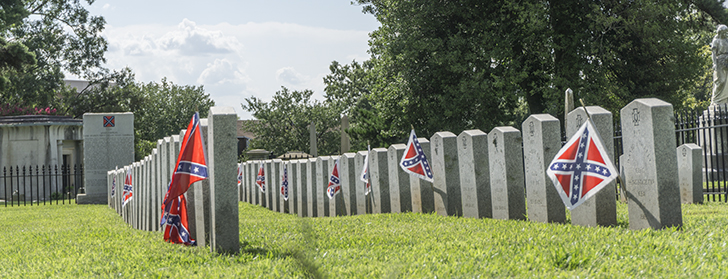As our city joins the nation in speaking up for racial justice and removing confederate street names, I decided to do some research into Charlotte’s history before, during, and just after “The Late War” of The 1860s (so named by Charlotte historian John Brevard Alexander).
I began my research by visiting the monuments and memorials of “The Late War” in and around Charlotte.
The largest of these currently sits in the middle of Elmwood Cemetery, in the Northwest corner of Uptown. It includes several large markers around the perimeter;

This one was moved from Old City Hall on Trade Street after it was vandalized in 2015;

The memorial features the largest obelisk in Charlotte in its center (which reads: To The Confederate Soldiers of Mecklenburg County – Erected by The Women of Charlotte 1887);

And over 250 grave markers for Confederate soldiers surrounding the center obelisk;

While researching the confederate plaques and inscriptions, I stumbled across one of Charlotte’s most prominent historians, John Brevard Alexander, who lived in Lemley’s Township, Mecklenburg County (now the western half of Huntersville) during the second half of the 19th century.
He wrote 2 books in particular that details life in Charlotte before and after “The Late War” of The 1860s; The History of Mecklenburg County from 1740 to 1900 and Reminiscences of the Past Sixty Years.
The first of these books talks about the beginnings of slavery in the Queen City:
“From the time Mecklenburg county was the home of the Caucasian race long before the meets and bounds of the county were designated or cut off from Anson the negro was employed as the slave of white men. At that early day they were not numerous according to population but as the population increased they became more numerous. The price in the early times for a grown negro either man or woman did not exceed three hundred dollars but before the Nineteenth century was half over the price of a good looking man or woman would range from $1,000 to $1,800. The market price varied according to the price of sugar rice tobacco and cotton. In this county it was no uncommon thing to find the finest blacksmiths carpenters tanners shoemakers and in fact all kinds of mechanics among the slaves. In the rice plantations of South Carolina the great cotton fields of the more tropical States of the South and wherever the negroes were worked under the overseers of the Southern States they did not have the advantages that were to be had in Mecklenburg.” (pg 125, The History of Mecklenburg County from 1740 to 1900)
As well as the formation of “The Charlotte Negro Patrols“;
“The climate and soil of Mecklenburg were suitable and were eminently fitted for slave labor to be profitable. In one hundred years the increase in numbers was very great notwithstanding large numbers were moved South and West as the citizens sought more fertile lands as the markets of the world were opened up to king cotton. It soon became the custom to sell all the bad negroes in fact the good people of a neighborhood would not tolerate a bad character at home either man or woman. One who was smart and given to crime had a most pernicious effect on those with whom he came in contact hence he was promptly sold out of the State. It was to prevent negroes from holding meetings at night and on Sundays for planning mischief that our county courts organized the patrol to keep the negroes from congregating at places unbeknown to their masters. They were permitted to go to the church of their choice and were not interfered with If they wanted to visit any of their friends at night or Sunday they could easily get a pass which would insure them safety from the patrol. The last twenty five years of their servitude the patrols were very vigilantly engaged in looking after the interests of the South. In about 1845 it was no unusual thing for Northern school teachers both men and women to come down South to teach school and frequently hold secret meetings with the negroes doing a great deal of harm to our system of labor and as abolitionists rendering the negroes dissatisfied with their lot. This was the prime cause of appointing a patrol.” (pg. 329-330, The History of Mecklenburg County from 1740 to 1900)
The second book I found relating to Charlotte’s confederate past is called Reminiscences of the Past Sixty Years, which was also written by John Brevard Alexander.
In this book, Alexander talks more about the time after the Civil War, including what happened immediately after Charlotte’s slaves were freed:
“Scarcely a negro in Mecklenburg county remained upon the farm. It was hard for them to realize that freedom was thrust upon them if they did not leave home. They collected in vast numbers around every town and village. The greatest pressing question was how was our crops to be worked. Our cotton crop was small as our chief aim was to raise bread stuff to feed the army So it did not require as much labor as when cotton was planted. Various schemes were tried to get the crops cultivated. We kept a large garden to supply the negroes with vegetables and this we turned to account by hauling to Charlotte and selling the vegetables to the Yankee soldiers. There was 6,000 troops stationed here to keep us in subjection.” (pg 9, Reminiscences of the Past Sixty Years)
Alexander then begins to paint an exaggerated “Lost Cause” picture of the reconstruction years:
“From 1865 1875 we lived in the Africanised South the most inconceivable government among men according to all the precedent of all the past when for the first time since the begining of time a white race undertook to put the feet of a colored race on the necks of the white men and women of their own blood and breed. No civilized or christian people has ever been forced to drink the gall and worm wood of defeat during the days of so called reconstruction.” (pg. 113-114, Reminiscences of the Past Sixty Years)
He also recounts a truly twisted version of the formation of the Ku Klux Klan in and around Charlotte:
“The Ku Klux Klan a secret oath bound brotherhood rose in a night disarmed every negro and restored civilization. The secret weapon with which they struck was the only one at their command and it was the most terrible and efficient in the history of the rebellion. The movement of these white and scarlet horsemen was like clockwork. They struck shrouded in a mantle of darkness and terror and they struck to kill. Discovery or retaliation was impossible. Their edicts were executed as by destiny without a word save the whistle of the Night Hawk the crack of his revolver and the hoof beat of swift horses moving like figures in a dream and vanishing like mists and shadows. The Southern people in their despair had developed the courage of the lion the cunning of the fox and the deathless faith of religious enthusiasts With magnificent audacity infinite patience and remorseless zeal a conquered people now turned his own weapon against the conqueror and beat his brains out with the bludgeon he had placed in the hands of former slaves And as a lawless band of night riders became the sole guardians of society brought order of chaos law out of lawlessness and preserved our race in America from extinction at least in negroid mongrelism. Had the South in this crisis become mulatto the nation would inevitably have sunk to its level.” (pg. 111-112, Reminiscences of the Past Sixty Years)
John Brevard Alexander is certainly not alone in painting such a skewed version of the past. Many other southern writers, historians, and politicians in the last 1800s and early 1900s attempted to frame slavery in the south in the best possible light – often going so far as to call the institution of slavery a positive thing for all involved.
This false narrative which framed many of the southern school books and encouraged the erection of most of the confederate statues and monuments became known as “The Lost Cause“.


